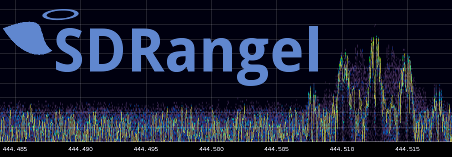 |
SDRAngel
4.11.5
Developer docs for <a href="https://github.com/f4exb/sdrangel">SDRangel<\a>, an Open Source Qt5 / OpenGL 3.0+ SDR and signal analyzer frontend to various hardware.
|
 |
SDRAngel
4.11.5
Developer docs for <a href="https://github.com/f4exb/sdrangel">SDRangel<\a>, an Open Source Qt5 / OpenGL 3.0+ SDR and signal analyzer frontend to various hardware.
|
These are all Python scripts using python-requests so you have to install this package as a prerequisite either with your package manager or pip. Some scripts work with Python 3 while others are still with Python 2.7.
Adds a channel to a device set specifying device set index and channel type.
devicesetChannelPost/sdrangel/deviceset/{deviceSetIndex}/channelPOSTConfigure a SDRangel instance with a sequence of API calls defined as a list in a JSON file. See test.json for an example.
It uses the following APIs:
devicesetDevicePut/sdrangel/deviceset/{deviceSetIndex}/devicePUTinstancePresetPatch/sdrangel/presetPATCHinstanceDeviceSetPost/sdrangel/devicesetPOSTinstanceDVSerialPatch/sdrangel/dvserialPATCHdevicesetDeviceRunPost/sdrangel/deviceset/{deviceSetIndex}/device/runPOSTCreate a Tx device set with a LimeSDR Tx device and a NFM modulator channel configured to send some beacon Morse code. Then starts the Tx.
It uses the following APIs:
instanceDeviceSetPost/sdrangel/devicesetPOSTdevicesetDevicePut/sdrangel/deviceset/{deviceSetIndex}/devicePUTdevicesetChannelPost/sdrangel/deviceset/{deviceSetIndex}/channelPOSTdevicesetChannelSettingsPatch/sdrangel/deviceset/{deviceSetIndex}/channel/{channelIndex}/settingsPATCHdevicesetDeviceRunPost/sdrangel/deviceset/{deviceSetIndex}/device/runPOSTExample of creating NFM channels (demodulator and modulator) and changing the settings
It uses the following APIs:
devicesetChannelPost/sdrangel/deviceset/{deviceSetIndex}/channelPOSTinstanceDeviceSetsPost/sdrangel/devicesetsPOSTdevicesetChannelSettingsPatch/sdrangel/deviceset/{deviceSetIndex}/channel/{channelIndex}/settingsPATCHHandles the switchover between two arbitrary device sets
Depends on flask and requests: to install do pip install flask requests in your virtual environment.
Implements a basic push to talk (PTT) feature. Verifies that devise set #0 is a Rx and that #1 is a Tx. Stops streaming on one device and start streaming on the other depending on the PTT move (Rx to Tx or Tx to Rx).
It uses the following APIs:
instanceDeviceSetsGet/sdrangel/devicesetsGETdevicesetDeviceRunPost/sdrangel/deviceset/{deviceSetIndex}/device/runPOSTdevicesetDeviceRunDelete/sdrangel/deviceset/{deviceSetIndex}/device/runDELETERandomize channel colors for a specified device set
It uses the following APIs:
devicesetGet/sdrangel/deviceset/{deviceSetIndex}GETdevicesetChannelSettingsGet/sdrangel/deviceset/{deviceSetIndex}/channel/{channelIndex}/settingsGETdevicesetChannelSettingsPatch/sdrangel/deviceset/{deviceSetIndex}/channel/{channelIndex}/settingsPATCHThis script runs continuously to act as the server side of SDRangel reverse API feature. It will respond with a copy of the settings when forwarding channel or device settings which is a valid reply and will also send back a valid reply when forwarding the device start/stop actions. The reverse API feature was implemented in version 4.3.2 and you can learn more about it in the Wiki.
It uses Python flask package for the server so you will need to either install it system wide or better create your own virtual environment and use the pip install flask command once your virtual environment is activated. If you know Python then you know what a virtual environment is about.
Then in the virtual environment do:
By default the server will listen on port 5000. It was used to conveniently test the reverse API but actually does not do much. It can serve as a base to implement more complex scenarios to control other devices or software or other instances of SDRangel.
Make sure a RTLSDR device is selected on device set #0. Get and change the settings of this RTLSDR device.
It uses the following APIs:
devicesetGet/sdrangel/deviceset/{deviceSetIndex}GETdevicesetDevicePut/sdrangel/deviceset/{deviceSetIndex}/devicePUTdevicesetDeviceSettingsGet/sdrangel/deviceset/{deviceSetIndex}/device/settingsGETdevicesetDeviceSettingsPatch/sdrangel/deviceset/{deviceSetIndex}/device/settingsPATCHSets specified Rx in existing source device set or create a new source device set with this Rx. Adds an NFM demodulator channel.
It uses the following APIs:
devicesetPost/sdrangel/devicesetPOSTdevicesetGet/sdrangel/deviceset/{deviceSetIndex}GETdevicesetDevicePut/sdrangel/deviceset/{deviceSetIndex}/devicePUTdevicesetDeviceSettingsGet/sdrangel/deviceset/{deviceSetIndex}/device/settingsGETdevicesetDeviceSettingsPatch/sdrangel/deviceset/{deviceSetIndex}/device/settingsPATCHdevicesetChannelPost/sdrangel/deviceset/{deviceSetIndex}/channelPOSTdevicesetChannelSettingsGet/sdrangel/deviceset/{deviceSetIndex}/channel/{channelIndex}/settingsGETdevicesetChannelSettingsPatch/sdrangel/deviceset/{deviceSetIndex}/channel/{channelIndex}/settingsPATCHdevicesetDeviceRunPost/sdrangel/deviceset/{deviceSetIndex}/device/runPOSTCombines rx_test and tx_test to create a pair of source and sink device sets. The APIs used are the same as in rx_test or tx_test.
Simple AM and NFM scanner with multiple equally spaced channels. Stops whenever any of the channels squelch opens. At the moment the following sampling devices can be used:
Check ./scanner.py --help for the options.
Requires numpy
☞ Try to first run with the -m (mock) option to see what the scanner parameters will be. In particular pay attention to the computed sample rate that should be within range for your hardware. For devices with fixed or discrete rates make sure the computed sample rate does not exceed the unique device sample rate or the highest possible sample rate.
In addition to some APIs being used in other script it uses:
devicesetChannelsReportGet/sdrangel/deviceset/{deviceSetIndex}/channels/reportGETStarts or stops a device in the specified device set
It uses the following APIs:
instanceDeviceSetsGet/sdrangel/devicesetsGETdevicesetDeviceRunPost/sdrangel/deviceset/{deviceSetIndex}/device/runPOSTdevicesetDeviceRunDelete/sdrangel/deviceset/{deviceSetIndex}/device/runDELETEThis works with a server instance only i.e. sdrangelsrv. It will shutdown the instance nicely as you would do with the exit menu or Ctl-Q in the GUI application.
It uses this API:
instanceDelete/sdrangelDELETESets specified Tx in existing sink device set or create a new sink device set with this Tx. Adds an NFM modulator channel.
It uses the following APIs:
devicesetPost/sdrangel/devicesetPOSTdevicesetGet/sdrangel/deviceset/{deviceSetIndex}GETdevicesetDevicePut/sdrangel/deviceset/{deviceSetIndex}/devicePUTdevicesetDeviceSettingsGet/sdrangel/deviceset/{deviceSetIndex}/device/settingsGETdevicesetDeviceSettingsPatch/sdrangel/deviceset/{deviceSetIndex}/device/settingsPATCHdevicesetChannelPost/sdrangel/deviceset/{deviceSetIndex}/channelPOSTdevicesetChannelSettingsGet/sdrangel/deviceset/{deviceSetIndex}/channel/{channelIndex}/settingsGETdevicesetChannelSettingsPatch/sdrangel/deviceset/{deviceSetIndex}/channel/{channelIndex}/settingsPATCHdevicesetDeviceRunPost/sdrangel/deviceset/{deviceSetIndex}/device/runPOST  1.8.13
1.8.13